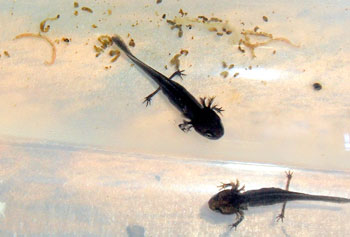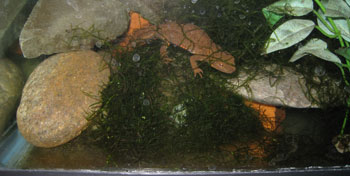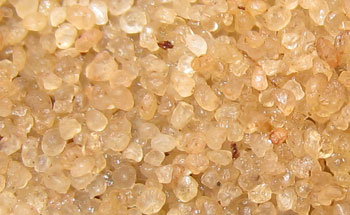Substrates for Caudates I: Aquatic substrates
By Johnny O. Farnen
Basics
In choosing a substrate for your aquatic caudate, you must first take a few things into account:
- How large and what species is the animal?
- Does it require hard or soft water?
- Does it prefer still water or flowing streams?
- Will it be fed by hand or allowed to hunt on its own?
- Will you use live plants?
- How easy will it be to clean?
The best way to address these questions is to start by learning everything you can about the specific species, both in the wild and in captivity. This will lead you into information on the other questions. Picking out the substrate, if any, will undoubtedly influence the health and happiness of your pet.
Avoiding Impaction
Most fully aquatic caudates are gape-limited predators, meaning that they will eat anything that fits into their mouths. Thus the choice of substrate is an important issue, as some of the substrate can be gulped down while feeding. This ingestion can cause choking or gastrointestinal impaction. In caudates, impaction is often fatal, as the owner does not notice an issue until it is too late. Impaction should be treated by a veterinary professional. Axolotls and other large aquatic species are at particularly high risk.
To decrease the risk of gastrointestinal impaction/obstruction, there are several options. If substrate is used in aquatic set ups, the size and type is dictated by the size and eating habits of the animals. Eliminating the use of substrate altogether is also a popular option. The use of sand is also utilized by many keepers. Many hobbyists layer their substrates with mixtures to keep the risky types buried from their animals. These options are discussed in more detail below.

Many hobbyists elect to use no substrate, for ease of feeding and cleaning, especially with larval caudates. Photo: Johnny Farnen, 2009.

In a tank with plenty of rocks and other ornaments, a "bare bottom" may not even be noticeable. Photo: Jennifer Macke, 2009.
No Substrate or "Bare Bottom" Tank
Substrate is not a requirement for keeping aquatic caudates. The ease of maintenance of a "bare bottomed" tank and the resulting stable water quality makes this an excellent method for large collections and for those short of time. The advantages of tanks with no substrate often outweigh the aesthetic issues. Water quality is significantly easier to maintain, since uneaten food and waste are easily observed and removed. Eggs are much more easily collected after they are deposited. The risk of loosing live foods into the substrate is eliminated. Impaction risk is completely eliminated.
Disadvantages are primarily aesthetic. Live plants must be kept free-floating, or in pots. A layer of algae will coat the tank bottom over time. The bulk of biological filtration is now placed into the tank filtration system, which requires extra vigilance and care to maintain beneficial bacteria.
Sand
Sand comes in many grades from ultra fine up to a size that can be considered gravel. Care in choosing which type and grade of sand must be used. Many commercially available reptile sands are comprised of calcium carbonate (i.e., Repti-Sand), and these should be avoided. High levels of calcium carbonate (CaCO3) can lead to pH and hardness changes and should be avoided. Marine sand, such as aragonite sold for aquarium use, is manufactured from crushed coral and is highly unsuitable due to the CaCO3 and sea salt in its composition.

Course sand that is about the same size as standard aquarium gravel. It is unsuitable for use with caudates that may ingest their substrate. Photo: Johnny Farnen, 2009.

Close-up photo of play sand. It contains a mixture of grain sizes. Photo: Johnny Farnen, 2009.

Close-up photo of pool filter sand. Grain size is approximately 0.5 - 1 mm. Photo: Jennifer Macke, 2009.
Silica sand (quartz sand) comes in many forms, from a manufactured product to harvested beach sand. It is internationally graded in three categories: fine (0.063 to 0.2 mm), medium (0.2 to 0.63 mm), and coarse (0.63 to 2.0 mm). This ISO standard will be used throughout the rest of the article for simplicity. The types of silica sand typically used in aquaria are play sand, pool filter sand (sold for use in swimming pool filters), and sand labeled for use in freshwater aquariums.
Any grade of sand may be used. In fact, play sand is usually a mixture of many grain sizes. One should keep in mind that the finer the grade of sand and the deeper it is used, the higher the risk of anaerobic decay. There is also a risk of filter motor and impeller damage when using very fine sand. The finest grades of sand include extremely small particles (rock dust), and this can cause severe clouding of tank water.
Play sand and pool filter sand should be examined with a magnet to detect the presence of magnetite, a magnetic iron ore. If an excess of particles stick to the magnet, the sand should not be used, as iron can cause health problems in amphibians. Also, iron particles will damage the magnetic impeller motor found in many types of filters.
Commercially available sand in pet shops is most often of the medium grade. It is appealing in that it comes in a wide range of colors, from the natural to the very unnatural. The down side is it is comparatively expensive.
Whatever its source, sand must be thoroughly washed with clean tap water to remove dust and debris. Play sand often contains a lot of dust, and it is very important to rinse it well before adding it to an aquarium. Sand is best washed outdoors, as it can cause damage to plumbing. The simplest way to wash sand is to place the dry sand in a large plastic container and flush it with water from a garden hose while stirring vigorously until the water runs clear. Once the water is running clear, let it settle for an hour. After it settles, the smallest particles and debris can be siphoned off easily, as these will settle in the top layer. Once the siphoning is completed, the wet sand should be treated with a standard water conditioning treatment to remove any chlorine, chloramine, or metals left from the washing process.
Sand should be added to a tank that is partially full of treated water. Sand is best at a thickness of no more than 3 cm (1.2 inch). Any deeper than this, and there will be an increased tendency for anaerobic decay (often called the black sludge), which can cause unsightly blooms of surface algae and eruptions of gas bubbles. Anaerobic bacteria are dangerous to amphibians, possibly contributing to serious infections.

Newt on pool filter sand. Note that the "monotony" of beige sand can be improved by including a few pebbles or river rocks. Photo: Jennifer Macke, 2009.
An hour should be allowed for the sand to settle once it has been smoothed out over the tank bottom before the rest of the water is added. To help prevent disturbing your substrate while adding water, a flat rock or saucer placed in the tank works very well when the water is poured on top of it. Once all the water is added and time is allowed for settling, any remaining loose media should be siphoned off at this time.
With this procedure completed, you can now add plants, wood and rocks. Now get the tank cycling.
It should be noted that it is possible to create hybridized substrates by layering sand, gravel, and river rocks. Use of fine sand for moving-water setups is not recommended. The sand can cause damage to tank filtration system motors if it gets sucked into intakes when stirred up by movement of the animals. By layering a thin layer of sand under a layer of gravel or rock, the disadvantages of each type of substrate are virtually eliminated.
Gravel

Standard sized fish tank gravel is a very high impaction risk, and should not be used without layering or permanently bonding it together. Photo: Johnny Farnen, 2009.

Limestone gravel, such as this, is unsuitable for aquatic use due to high levels of calcium carbonate. Photo: Johnny Farnen, 2009.
Aquarium gravel is also an option for some aquatic caudates. It is readily available in a multitude of sizes and colors. It is often sealed by the manufacturer with acrylic resins. Gravel sold for construction and gardening should not be used, as it is often comprised of rock unsuitable for submerged aquaria use.
Gravel is any rock product ranging in size from 2 mm (about 1/12th of an inch) to 64 mm (about 2.5 inches). While standards for the size of off-the-shelf aquarium gravel vary internationally and between companies, it is usually in the 3-6 mm (roughly 1/8th inch) range.
Note: Aquarium gravel should be used with extreme caution! The danger of accidental ingestion and impaction is very high for some species. Many impaction-related caudate injuries and deaths are a direct result of the use of aquarium gravel.
For some species, such as axolotls, gravel should not be used. For caudates that are less prone to ingestion, there are some things that can be done to decrease the risk. For example, when caudates are fed with tongs or from a dish, they are less likely to accidentally ingest substrate. Larger sizes of gravel can be used with a higher safety margin, depending on the size of the specimens.
Another option is to permanently bond the gravel together to the aquarium floor with epoxy or aquarium-safe silicone adhesive. This creates a solid, heavy, textured substrate that is pleasing to the eye, yet is impossible to ingest. It is also very easy to keep clean with regular siphoning and the occasional use of a stiff bristled brush.
Use of loose gravel to create sloping areas or islands of land should be avoided. The extra depth of the gravel creates prime conditions for the buildup of waste. This invariably leads to anaerobic decay resulting in severe water chemistry instability and sick or dead caudates. The total thickness of any layer of aquarium gravel used is best kept to less than 4 cm (1.5 inch). Having only a thin layer will make cleaning easier and prevent the development of anaerobic conditions.
River Rock
Polished river rocks are readily available in pet, home improvement and hobby stores. The size of these stones prevents accidental ingestion by your pets, and their beauty is aesthetically pleasing. When used in layers with other substrates, they provide a very natural looking installation that also protects plants from being uprooted.
Care must be taken when choosing river rock. The size of your caudate's mouth should be the most important factor. The rocks should be at least as large as the animal's entire head. There are many sizes types and grades available. River rock purchased in bulk often contains a mixture of sizes, many of which are unsafe for caudates. In this case, the river rock should be sorted by size. A sieve made of hardware cloth can greatly speed this process.

River rock, when used alone or layered with gravel is a suitable substrate for large aquatic caudates. Note that the pieces are larger than the animal's head. Photo: Johnny Farnen, 2009.
The downside to this type of aquatic substrate is that it provides many places for food items to escape and waste to collect. This can lead to severe water chemistry issues. When using a large grade substrate like river rock, extra care must be used when cleaning the tank to get any trapped waste or uneaten food removed.
There are two very simple options to solving this problem. The first, and probably least expensive, is to do a hybrid substrate with sand and river rock. The sand fills in the gaps between the rocks and prevents waste from collecting. From time to time, if this method is used, it may be necessary to stir the substrate up a bit to prevent anaerobic bacterial activity. This is often one of the best choices for heavily planted tanks, as the hybrid substrate does double duty. The river rocks prevent accidental ingestion by the animals and also help keep the plants in place. A Hybrid Substrate is also very pleasing to the eye.
The other option is to permanently encase the river rock substrate with aquarium safe silicone or epoxy resin. This creates a permanent substrate that looks very natural and provides nowhere for detritus to collect. The necessity for planning, the required project time, and the expense of this option discourages most small scale hobbyists from using it. This option is generally reserved for very large tanks and should only be attempted by experienced aquarists.
River rock can be purchased in a variety of sizes and colors. It should always be rinsed well in tap water. It should also be allowed to soak in water overnight. If any discoloration or change in the pH of the water is noticed the next day, the product should not be used in an aquarium.
River rock should be washed and treated with the same methods used for sand and larger rocks.
Tile Substrate

Example of a setup where most of the tank bottom is covered by slate tile. Photo: Mark Aartse-Tuyn, 2009.
Another option preferred by some hobbyists is the tiled substrate. Very simply put, pieces of slate or tile are cut to fit the aquarium floor. These can be neatly arranged and "grouted" with play sand or glued in permanently with epoxy or silicone. This method also makes for very pleasing aquatic backgrounds in a caudate tank.
Care must be taken to remove any sharp edges from this substrate before permanently affixing it in place. This can be done easily with a file or rotary tool like a Dremel.
There are very few disadvantages to this type of substrate. If live plants are used, they must be free-floating or potted.
References and Further Reading
The Ecology & Behavior of Amphibians. K.D. Wells. University of Chicago Press, 2007.
Manual of Exotic Pet Practice. Mark Mitchell and Thomas Tully. Elsevier Health Sciences, 2008.
Recommendations for the Care of Amphibians and Reptiles in Academic Institutions.
F. Harvey Pough. National Academy Press, Washington, D.C., 1992
http://netvet.wustl.edu/species/reptiles/pough.txt
The Axolotl Website, Housing information
https://www.axolotl.org/housing.htm
US Department of the Interior/ US Geological Survey
Mineral Commodity Summaries 2006
https://www.usgs.gov/centers/national-minerals-information-center/mineral-commodity-summaries
Contains detailed information and links about sand, gravel and commonly available rock, including toxicity information.
Exo-Terra Substrates
https://exo-terra.com/products/substrates/
Examples of commercially available substrates.
© 2009 Johnny O. Farnen
